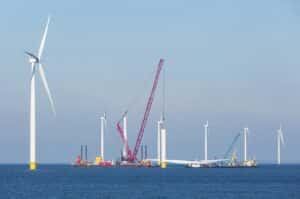
A wind farm under construction off the Dutch coast in 2016. Development of major offshore wind turbine projects south of Martha’s Vineyard should be in high gear by 2023.
Vineyard Wind appears to have regained its place at the front of the offshore wind project permitting line and is back on track to becoming the first utility-scale offshore wind farm in the United States.
The federal Bureau of Ocean Energy Management announced Wednesday afternoon that it will resume its review of the 800-megawatt wind farm planned for 15 miles south of Martha’s Vineyard and will “proceed with development of a Final Environmental Impact Statement,” one of the last steps before the project can truly get underway. The decision could help ensure Massachusetts starts getting clean power from the project by the end of 2023.
“We’re very pleased that BOEM has decided to move forward with the permitting process for our Vineyard Wind 1 project,” a Vineyard Wind spokesperson said. “We look forward to working with the agency as we launch an industry that will create thousands of good paying jobs while also taking meaningful steps to reduce the impact of climate change.”
Local officials on the South Coast hope that their region will see significant industrial growth from the wind projects. Officials in New Bedford have established tax incentives for new industrial developments in certain neighborhoods.
Following a string of permitting delays imposed on the project by the Trump administration, Vineyard Wind on Dec. 1 announced that it was pulling its project out of the federal review pipeline in order to complete an internal study on whether the decision to use a certain type of turbine would warrant changes to construction and operations plan. The Trump administration declared the federal review of the project “terminated.”
Vineyard Wind’s decision to yank its plan from review also meant the project’s ultimate fate would not be decided under Trump, who frequently expressed concerns about wind power and held the project back while his administration looked into impacts that the burgeoning industry will have on commercial fishing.
The company said last week that its internal review determined that no changes are needed to its construction and operations plan and that “the Federal Permitting Process can be completed” by BOEM. The company said it had not had any detailed discussions with the Biden administration about how its request to resubmit its construction and operations plan would be handled.
The decision to pick up the Vineyard Wind review from where it stood just before the company withdrew its plan appears to have been among the first orders of business for Amanda Lefton, who was announced as the new director of BOEM earlier Wednesday. Before being drafted into the Biden administration, Lefton served as New York Gov. Andrew Cuomo’s first assistant secretary for energy and environment and had previously worked for The Nature Conservancy in New York.
“Offshore wind has the potential to help our nation combat climate change, improve resilience through reliable power, and spur economic development to create good-paying jobs,” Lefton said in announcing BOEM’s intention to resume the Vineyard Wind review. “BOEM is committed to conducting a robust and timely review of the proposed project.”
The proposed wind farm was the first offshore wind project selected by Massachusetts utility companies with input from the Baker administration to fulfill part of a 2016 clean energy law. It is projected to generate cleaner electricity for more than 400,000 homes and businesses in Massachusetts, produce at least 3,600 jobs, reduce costs for Massachusetts ratepayers by an estimated $1.4 billion, and eliminate 1.68 million metric tons of carbon dioxide emissions annually.
State Energy and Environmental Affairs Secretary Kathleen Theoharides said BOEM’s announcement is also good news for the 800-megawatt Mayflower Wind project that is expected to produce power for Massachusetts and for future offshore wind projects. Since Vineyard Wind’s project is the furthest along in the federal permitting process, it inherently sets a precedent for the projects that will come after it.
“I think this is a very good sign that the administration is very interested in pursuing offshore wind for its climate benefits, for its jobs benefits, for the reliable, clean energy it can deliver, and we hope and look forward to a permitting process that is predictable and efficient,” the secretary said.
Vineyard Wind CEO Lars Pedersen said last week that the company would expect that the federal agency would publish its final environmental impact statement and then issue its record of decision “sometime in the first half of 2021” as long as Biden’s BOEM approved its request to resume the project’s review.
That would allow the project to hit its financial close milestone sometime in the second half of this year, begin on-shore work quickly thereafter, start offshore construction in 2022, begin installing turbines in 2023 and begin exporting power to the grid in late 2023, Pedersen said.






